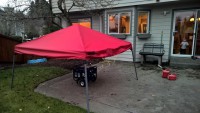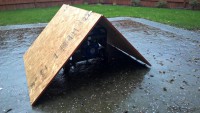 After coming home from vacation in August in the middle of a power outage, Tyla and I decided to buy a generator. It wasn’t anything fancy, but it would be a big help. I figured we’d never lose power again since we finally shelled out money for a generator. Wrong!
After coming home from vacation in August in the middle of a power outage, Tyla and I decided to buy a generator. It wasn’t anything fancy, but it would be a big help. I figured we’d never lose power again since we finally shelled out money for a generator. Wrong!
On Nov 17, we had a really big windstorm and it knocked out power for around 300,000 homes. We lost power at 2:15pm. After waiting an hour to make sure it wasn’t a short term outage, I headed home to fire up the generator. We ended up getting power again at 12:15pm the next day, but even with the 22 hour outage, we succeeded in keeping the fridge running, using a space heater to keep the eating area warm, and running some lights. It’s amazing how much better it feels just having lights on in an outage like that!
Tyla and I have really ramped up our disaster prep in the past couple months and I’d give us a B- on this event. Here are some of the things I learned:
- It never occurred to me that when I need a generator, there’s a good chance that it’s raining. The generator shouldn’t sit in the rain so it needs protection. I used our pop up tent but that was a little sketchy given the high winds. I thought it was going to blow away. I think I’ll try to fashion some kind of plywood that just sits on top and latches on to provide a rain shelter. It will be a lot faster to set up, and if I make it correctly, it will be easy enough to store along a wall in the shed.
- It also never occurred to me that because we were running an extension cord inside, we’d have to leave a door or window cracked open which lets heat escape. I got around this by jamming a large towel in the crack and that helped.
- We have a bunch of small battery backups around the house basically wherever we have fancy electronics (computer closet, desktop computer, theater setup, and downstairs TV). Those are really handy in power outages because you just move them wherever you want power and plug in a lamp, etc. They’ll run LED bulbs and charge phones for quite a while. Unfortunately, I was not able to charge them back up with the generator. While the generator provides a pretty clean voltage signal, the frequency fluctuated about +/- 1Hz from 60Hz. That was enough to make the battery backups freak out and keep switching back to battery mode. My initial plan had been to run the generator into various battery backups and then run equipment off of those batteries to keep the signal really clean. That failed so I had to hook things up without that battery in the middle and I was a little nervous about the dirty power running to stuff like the fridge which has lots of electronics in it. Everything worked ok so maybe I was worried about nothing. It would still be nice to find a cheap way to clean up the power signal a bit so we could use the batteries more effectively.
- I was shocked at how little power the fridge used! I don’t know what the startup surge was, but once running, it only used 150 watts! If you put it in “Max Cool” it would ramp up to 500 watts once it pushed below 0 degrees in the freezer, but 150 watts? I could probably have been running this off my battery backups all along! Sure it wouldn’t have lasted indefinitely but I could have at least gotten one or two cooling cycles in the fridge.
- The next time we think that the power might go out, we should set our fridge to Max Cool. It drops the temps by about 5 degrees in the fridge and freezer for the next 24 hours. If the power does go out, that gives us more runway before we have to use the generator.
- I had no idea how quickly the generator would use gas. It was dependent on our usage and it turns out that we used very little of the available capacity. I never really saw the gas gauge move. Unfortunately I topped the tank off a couple times so I can’t get an accurate measurement of the gas we used when I drain the tank, but still, it would easily have run for many hours.
- Because of the concern about running out of gas (which can damage connected devices) and because I didn’t necessarily trust the generator to run trouble-free, I didn’t let it run overnight to keep the fridge cool. That meant setting an alarm every ~2.5 hours to wake up, turn on the generator, and run the fridge for 30-45 minutes to cool it back down. It was a very restless night for me.
- The overnight temp dropped into the mid 30’s. We keep the house at 69 degrees and by morning it was down to 59. If it was just Tyla and me, we could survive but it’s hard with a toddler who likes to throw off blankets while he sleeps. I was prepared to use our 1400 watt space heater in the bedroom periodically the next night, but then I chatted with our HVAC guru and he approved my plan to hook the furnace up to the generator. When he installed it, he put a switch in the line so my plan was to take the switch apart, wire in a male extension cord plug and then connect it to the generator with an extension cord. I don’t know how much wattage it would draw, but it’s a gas furnace so I just have to run the blower so I should have plenty of juice. It would have been awesome to get the house warmed up, but doing that also meant that when the power came back on, I’d have to undo my change to have the furnace running on the power grid again. In the future I think I’d probably wait until the house got really cold to do this, but it’s awesome to know that I CAN do it in a pinch.
- We had already been considering adding wiring to our panel so that we can transfer over to the generator. I’m still interested in that and it would have made our experience a lot nicer, but I’m still not sure it’s worth the money. I’m batching up some other panel work that I want to have done (whole house surge protector and per-circuit usage monitoring/logging) so maybe it will make more economic sense to do them all at the same time. Now that I know how much work is involved manually hooking things up, I have a better feeling for how valuable it is to have it wired into the panel.
- Food and water were never a concern. We have a big bin of food stored in the pantry that is our “emergency stash.” As long as we have some kind of fire, there’s lots of food that we can eat and the food will keep for at least a year in that bin. We didn’t even have to break into that bin though.
- Our gas supply was inadequate. Now that I know how much gas the generator uses, I will keep more on hand. Previously I had 2 gallons in the garage, but I’m bumping that up to 8. I’ll keep rotating it every few months to make sure that it doesn’t go bad.
Overall I’m very happy we bought the generator. At less than $500, I feel like we’ve already come a long way towards feeling like we got enough value out of it to make it a good purchase. The next time this happens, I will have a lot better idea what to expect and will hopefully be able to relax a little more. This time felt pretty hectic and I didn’t get much sleep.
 After our previous multi-day power outage, I wrote a post talking about what I learned from my first real test with the generator and gave myself a B-. Unfortunately, I had another test recently when the third windstorm of March knocked out power for 175,000 people. Thankfully, this outage only lasted 11 hours so it was easier to deal with, but I’d still bump us up to a B+. Here’s a breakdown of what I learned this time around:
After our previous multi-day power outage, I wrote a post talking about what I learned from my first real test with the generator and gave myself a B-. Unfortunately, I had another test recently when the third windstorm of March knocked out power for 175,000 people. Thankfully, this outage only lasted 11 hours so it was easier to deal with, but I’d still bump us up to a B+. Here’s a breakdown of what I learned this time around:
